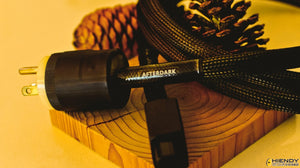Raspberry Pi 週刊 第九期
July 04, 2018

本週店主會談談, 使用不同電源線於樹莓派時的影響。有一天客戶問店主:使用廠家LPS的電源線和發燒電源線有什麼不同?店主答復:Raspberry Pi 3對電源線是非常敏感,電線的屏蔽效果越好,圖像和聲場越好。這對所有發燒友來說都是正常的。電源線的屏蔽在設計時起著重要的作用。玩Raspberry Pi 3的藝術就是,客戶感覺到每一次小升級的體驗。我們有客戶一開始時使用開關電源,之後用更好的線性電源升級,升級電源線,之後升級DC電源線,CAT 7網線升級等等,每一個小改進之後都變成大改進。店主的目的是提供更多的定制服務,以照顧客戶,進行修改。我們與大多數客戶分享產品開發流程,當產品合適時,我們將會做更多的相關產品。這就是店主改變銷售Raspberry Pi 3的營銷方式的原因,銷售總是由朋友和前客戶推薦。 AfterDark. Respberry Pi 3 正在成為本店獨特的產品,因為店主總是想嘗試不同的東西。嘗試製造新產品,當所有手工製作的產品完成以後, 成為一系列AfterDark. 的經典之作。例如,AfterDark. Clementine Power Cable 1.82M , Constallation CAT7 Network Cable Telegartner Edition 也是去年最暢銷的產品之一。作為AfterDark的Evolution產品。店主將會應用更多碳纖維屏蔽 Carbon Fiber Shielding(CFS)技術。基於這個原因, 店主將為Project ClayX 啟動一個新子產品線, 名為“Black Moderniza”的首款概念產品, 將使用Carbon Fiber NanoTube (CNT) 碳納米管技術 “Made to Measure” iFi AC iPurifier以提升主體的EMI屏蔽性能和表面紋理的質量,首款產品將於2018年2月上市。AfterDark. Project ClayX Black Moderniza audiophileTUBE for iFi AC iPurifier:
關於技術的話題:
碳纖維屏蔽(CFS)技術VS EMI屏蔽性能熱塑性複合材料是新一代碳纖維複合材料。除了用於汽車和消費電子產品之外,這種新一代複合材料的目標是替代外殼和EMI屏蔽材料中的金屬。主要特點是使用高容量成型技術和塗層,以提供相當於金屬的EMI屏蔽。 TE一直在積極研究複合材料,並改進其生產方法。一個典型的熱塑性複合材料從一個高性能工程塑料開始,添加了填料以增強特性。對於電子外殼,塑料很可能是高溫可塑熱塑性塑料,例如PPS,PEI,PEEK或LCP等級。實際的熱塑性塑料通常由所需的操作溫度和可能看到的流體暴露的組合來確定。儘管玻璃纖維是用於增加結構強度的最常用的填充材料,但是需要碳纖維或其他導電填料來生產具有良好EMI性能的材料。金屬填料是一種可能性,但有時因為它們添加到材料上的重量而被打折扣。碳可以以多種形式添加:作為碳納米管(CNT),石墨烯薄片,短或長的碳纖維,碳微球和簡單的碳顆粒。圖2總結了每個的好處。這些填充材料使塑料導電,以提供EMI屏蔽。填充CNT的塑料的體電阻率可以小於10Ω-cm 5至10%填充體積,並且小於1Ω.cm,50%體積。額外的電導率有時可以通過金屬塗覆碳基填料來獲得。所選擇的碳的類型將對所得複合材料的強度具有顯著影響。例如,長碳纖維可以用來增加材料的強度和硬度,使其等於甚至超過金屬。
EMI屏蔽由於任何電子系統都必須在其電磁環境中工作,EMI的控制是至關重要的。屏蔽是一個EMI控制的關鍵部分。 EMI保護是一條雙向的街道。一個系統必須控制自己的一代EMI,以便它不會干擾其他系統。同時,系統必須受到保護,免受外界的干擾源。屏蔽既可以抑制內部產生的噪聲,又可以防止外部干擾。金屬外殼提供優秀的屏蔽。非複合塑料外殼對EMI是透明的。綜合可以設計不同級別的屏蔽效能的外殼。用戶不僅要確定的程度所需的屏蔽,還有必須處理的頻率。屏蔽效果隨頻率而變化。金屬外殼主要通過反射能量來提供EMI保護。這是無用能量時的一個優勢來自外殼之外。當外殼內的電子器件產生EMI輻射時,能量可以達到反射回電子而不是被淘汰。另一方面,複合外殼提供了一個反射和吸收的結合。碳纖維填料表現出比金屬低得多的電導率。與金屬類似,這些材料將傳導EMI。然而,它們的傳導率較低意味著EMI被吸收並作為熱量消散而不是被傳導地面。外殼可以通過使填充物更具導電性(即更多的金屬樣)而實現更好的屏蔽效能, 或者在外殼上增加一層金屬。
Quoted from:
AEROSPACE, DEFENSE & MARINE /// WHITE PAPER
http://www.te.com/content/dam/te ... eight-shielding.pdfOne day customer asked: Is there are big different when using the factory cable come with LPS vs audiophile power cable? The shop owner reply: There is a big different when you compared. The Respberry Pi 3 is really sensitive to the power cable, the better the shielding of the cable, the better the image and soundstage. This is normal apply to all audiophile gear. The shielding of the power cable plays a important role when designing the power cable. The art of playing Raspberry Pi 3 is that, most customer experience the step up with each small upgrades. We have customer playing with switching power supply, upgrades with better Linear Power Supply, upgrade the power cable, DC cables upgrades, CAT 7 network cable upgrades, every small improvement counts to big step up. The shop owner aims to provide more customerize made to measure service to all customers, for modification. We shares the product development process with most customers, when the product is right, we do more for everyone. That's why we sllightly changing the marketing approach on selling Raspberry Pi 3, selling is always by referral from friends, with ex-customers. AfterDark. Respberry Pi 3 is becoming the unique product as the shop owner always want to try something different. We tried and experiment with new products, all together become a series of classic. For example, AfterDark. Clementine Power Carbon fiber Shielding Cable 1.82M is one of our best selling product from last year. The evolution product from AfterDark. is the based on Carbon Fiber Shielding (CFS) Technology. The shop owner will start a new sub product line called "Black Moderniza" for Project ClayX Products. The first product will be "made to measure" to enhance the performance and outlook on iFi AC iPurifier, the first production will be start next month on Feb 2018.Carbon Fiber Shielding (CFS) Technology Vs EMI shielding performanceThemoplastic Composites Fortunately, a new generation of carbon fiber composites is addressing the need for cost-effective, high-throughput parts. Beyond uses in automotive and consumer electronics, this new generation of composites is targeted at replacing metals in enclosures and EMI shields. Key features are the use of high-volume molding techniques and coatings to provide EMI shielding equivalent to metals. TE has been actively researching composite materials and improved methods of producing them in practical shapes. A typical thermoplastic composite begins with a high-performance engineered plastic to which fillers are added to enhance characteristics. For electronic enclosures, the plastic is likely to be a high-temperature moldable thermoplastic, such as grades of PPS, PEI, PEEK, or LCP. The actual thermoplastic is usually determined by a combination of required operating temperature and the fluid exposure likely to be seen. While glass fibers have been the most commonly used filler materials for adding structural strength, carbon fibers or other conductive fillers are required to produce materials with good EMI performance. Metal fillers are a possibility but are sometimes discounted because of the weight they add to the material. Carbon can be added in many forms: as carbon nanotubes (CNTs), graphene platelets, short or long carbon fibers, carbon microspheres, and simple carbon particles. Figure 2 summarizes the benefits of each. These filler materials make the plastic conductive to provide EMI shielding. The bulk resistivity of CNT-filled plastic can be less than 10 Ω-cm @ 5 to 10 percent filler volume and under 1 Ω-cm @ 50% percent volume. Additional conductivity can sometimes be obtained by metal coating the carbon-based fillers. The type of carbon selected will have significant effect on the strength of the resulting composite material. Long carbon fibers, for example, can be used to increase the strength and hardness of the material to equal or even surpass metal.EMI ShieldingSince any electronic system must work within its electromagnetic environment, control of EMI is critical. Shielding is a critical part of EMI control. EMI protection is a two-way street. A system must control its own generation of EMI so that it does not interfere with other systems. At the same time, the system must be protected from interference from outside sources. Shielding works both to contain internally generated noise and to protect against outside interference.Metal enclosures offer excellent shielding. Noncomposite plastic enclosures are transparent to EMI. Compositeenclosures can be designed with varying levels of shielding effectiveness. Users must not only determine the degree of shielding required, but also the frequencies that must be dealt with. Shielding effectiveness varies with frequency. A metal enclosure provides EMI protection mainly by reflecting energy. This is an advantage when the unwanted energy comes from outside the enclosure. When EMI is radiated by the electronics within the enclosure, energy can be reflected back into the electronics instead of being eliminated. Composite enclosures, on the other hand, provide a combination of reflection and absorption.Carbon-fiber fillers exhibit significantly less conductivity than metal. Similar to metal, these materials will conduct EMI. However, their less efficient conductivity means EMI is absorbed and dissipated as heat rather than being conducted to ground. Enclosures can achieve better shielding effectiveness by either making the fillers more conductive (i.e., more metal-like) or by adding a layer of metal to the enclosureQuoted from:
AEROSPACE, DEFENSE & MARINE /// WHITE PAPERhttp://www.te.com/content/dam/te ... eight-shielding.pdf
Happy Easter Holiday

All products 10% Off
Discount Code: HE2025


